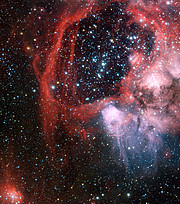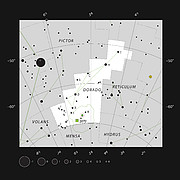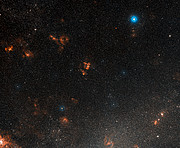Nota de prensa
Una superburbuja cósmica
20 de Julio de 2011
El Very Large Telescope de ESO capturó esta vista impresionante de la nebulosa alrededor del cúmulo de estrellas NGC 1929 en la Gran Nube de Magallanes, una galaxia satélite de nuestra Vía Láctea. Esta guardería estelar está dominada por un ejemplar colosal de lo que los astrónomos llaman una superburbuja. Su forma está siendo esculpida por los vientos de brillantes estrellas jóvenes y las ondas expansivas de las explosiones de supernovas.
La Gran Nube de Magallanes es una pequeña galaxia vecina a la Vía Láctea. Contiene muchas regiones donde las nubes de gas y polvo están formando nuevas estrellas. Una de estas regiones, alrededor del cúmulo estelar NGC 1929, domina esta nueva imagen obtenida con Very Large Telescope de ESO, situado en la Región de Antofagasta en Chile. Esta nebulosa es conocida oficialmente como LHA 120-N 44, o simplemente N 44. Estrellas jóvenes y calientes en NGC 1929 emiten intensa luz ultravioleta que hace brillar el gas. Este efecto permite que resalte la llamada superburbuja, un inmenso globo de material de unos 325 por 250 años-luz de diámetro. Comparativamente, la estrella más cercana a nuestro Sol se encuentra a poco más de cuatro años-luz de distancia.
La superburbuja N 44 se produjo por la combinación de dos procesos. En primer lugar, los vientos estelares -flujos de partículas cargadas provenientes de estrellas muy calientes y masivas en el cúmulo - limpiaron la región central. Posteriormente, las estrellas masivas del cúmulo explotaron como supernovas creando ondas expansivas que empujaron el gas hacia afuera y formaron la brillante burbuja.
Si bien la superburbuja nace de fuerzas destructivas, nuevas estrellas se están formando alrededor de los bordes, donde el gas está comprimido. Como un reciclaje a escala cósmica, esta nueva generación de estrellas traerá nuevos aires de vida a NGC 1929.
La imagen fue creada por ESO a partir de datos astronómicos encontrados por Manu Mejías, de Argentina [1], quien participó en el concurso de astrofotografía Tesoros Escondidos de ESO 2010 [2]. El concurso fue organizado por ESO en octubre-noviembre de 2010, para todos los que disfrutan creando bellas imágenes del cielo nocturno a partir de datos astronómicos obtenidos con telescopios profesionales.
Notas
[1] Manu revisó minuciosamente el archivo astronómico de ESO e identificó un grupo de datos que finalmente utilizó para componer su imagen de NGC 1929, la que obtuvo el séptimo lugar en la competencia, entre casi 100 postulaciones. Su imagen original se puede ver aquí.
[2] El concurso Tesoros Escondidos de ESO 2010 dio a los astrónomos aficionados la oportunidad de buscar al interior de los vastos archivos de datos astronómicos ESO, con la esperanza de encontrar una joya oculta que pudiera ser pulida por los participantes. Para obtener más información acerca de Tesoros Escondidos, visita el sitio en inglés http://www.eso.org/public/events/hiddentreasures/.
Información adicional
ESO, el Observatorio Europeo Austral, es la principal organización astronómica intergubernamental en Europa y el observatorio astronómico más productivo del mundo. Es apoyado por 15 países: Alemania, Austria, Bélgica, Brasil, Dinamarca, España, Finlandia, Francia, Holanda, Italia, Portugal, el Reino Unido, República Checa, Suecia y Suiza. ESO desarrolla un ambicioso programa enfocado en el diseño, construcción y operación de poderosas instalaciones de observación terrestres que permiten a los astrónomos hacer importantes descubrimientos científicos. ESO también cumple un rol principal en promover y organizar la cooperación en investigación astronómica. ESO opera tres sitios únicos de observación de clase mundial en Chile: La Silla, Paranal y Chajnantor. En Paranal, ESO opera el Very Large Telescope, el observatorio óptico más avanzado del mundo y dos telescopios de rastreo. VISTA trabaja en el infrarrojo y es el telescopio de rastreo más grande del mundo y el VST (sigla en inglés del Telescopio de Rastreo del VLT) es el telescopio más grande diseñado exclusivamente para rastrear el cielo en luz visible. ESO es el socio europeo de un revolucionario telescopio, ALMA, el proyecto astronómico más grande en desarrollo. ESO está actualmente planificando el European Extremely Large Telescope, E-ELT, el telescopio óptico y de infrarrojo cercano de la categoría de 40 metros, que llegará a ser “el ojo más grande del mundo en el cielo”.
Enlaces
Contactos
Douglas Pierce-Price
ESO, Public Information Officer
Garching bei München, Germany
Teléfono: +49 89 3200 6759
Correo electrónico: dpiercep@eso.org
Francisco Rodríguez (Contacto para medios de comunicación en Chile)
Red de Difusión Científica de ESO
y European Southern Observatory
Teléfono: +56-2-463-3151
Correo electrónico: eson-chile@eso.org
Acerca de la nota de prensa
| Nota de prensa No.: | eso1125es-cl |
| Nombre: | LHA 120-N 44 |
| Tipo: | Milky Way : Star : Grouping : Cluster Milky Way : Nebula |
| Facility: | Very Large Telescope |
| Instruments: | FORS1 |
Our use of Cookies
We use cookies that are essential for accessing our websites and using our services. We also use cookies to analyse, measure and improve our websites’ performance, to enable content sharing via social media and to display media content hosted on third-party platforms.
ESO Cookies Policy
The European Organisation for Astronomical Research in the Southern Hemisphere (ESO) is the pre-eminent intergovernmental science and technology organisation in astronomy. It carries out an ambitious programme focused on the design, construction and operation of powerful ground-based observing facilities for astronomy.
This Cookies Policy is intended to provide clarity by outlining the cookies used on the ESO public websites, their functions, the options you have for controlling them, and the ways you can contact us for additional details.
What are cookies?
Cookies are small pieces of data stored on your device by websites you visit. They serve various purposes, such as remembering login credentials and preferences and enhance your browsing experience.
Categories of cookies we use
Essential cookies (always active): These cookies are strictly necessary for the proper functioning of our website. Without these cookies, the website cannot operate correctly, and certain services, such as logging in or accessing secure areas, may not be available; because they are essential for the website’s operation, they cannot be disabled.
Functional Cookies: These cookies enhance your browsing experience by enabling additional features and personalization, such as remembering your preferences and settings. While not strictly necessary for the website to function, they improve usability and convenience; these cookies are only placed if you provide your consent.
Analytics cookies: These cookies collect information about how visitors interact with our website, such as which pages are visited most often and how users navigate the site. This data helps us improve website performance, optimize content, and enhance the user experience; these cookies are only placed if you provide your consent. We use the following analytics cookies.
Matomo Cookies:
This website uses Matomo (formerly Piwik), an open source software which enables the statistical analysis of website visits. Matomo uses cookies (text files) which are saved on your computer and which allow us to analyze how you use our website. The website user information generated by the cookies will only be saved on the servers of our IT Department. We use this information to analyze www.eso.org visits and to prepare reports on website activities. These data will not be disclosed to third parties.
On behalf of ESO, Matomo will use this information for the purpose of evaluating your use of the website, compiling reports on website activity and providing other services relating to website activity and internet usage.
Matomo cookies settings:
Additional Third-party cookies on ESO websites: some of our pages display content from external providers, e.g. YouTube.
Such third-party services are outside of ESO control and may, at any time, change their terms of service, use of cookies, etc.
YouTube: Some videos on the ESO website are embedded from ESO’s official YouTube channel. We have enabled YouTube’s privacy-enhanced mode, meaning that no cookies are set unless the user actively clicks on the video to play it. Additionally, in this mode, YouTube does not store any personally identifiable cookie data for embedded video playbacks. For more details, please refer to YouTube’s embedding videos information page.
Cookies can also be classified based on the following elements.
Regarding the domain, there are:
- First-party cookies, set by the website you are currently visiting. They are stored by the same domain that you are browsing and are used to enhance your experience on that site;
- Third-party cookies, set by a domain other than the one you are currently visiting.
As for their duration, cookies can be:
- Browser-session cookies, which are deleted when the user closes the browser;
- Stored cookies, which stay on the user's device for a predetermined period of time.
How to manage cookies
Cookie settings: You can modify your cookie choices for the ESO webpages at any time by clicking on the link Cookie settings at the bottom of any page.
In your browser: If you wish to delete cookies or instruct your browser to delete or block cookies by default, please visit the help pages of your browser:
Please be aware that if you delete or decline cookies, certain functionalities of our website may be not be available and your browsing experience may be affected.
You can set most browsers to prevent any cookies being placed on your device, but you may then have to manually adjust some preferences every time you visit a site/page. And some services and functionalities may not work properly at all (e.g. profile logging-in, shop check out).
Updates to the ESO Cookies Policy
The ESO Cookies Policy may be subject to future updates, which will be made available on this page.
Additional information
For any queries related to cookies, please contact: pdprATesoDOTorg.
As ESO public webpages are managed by our Department of Communication, your questions will be dealt with the support of the said Department.





